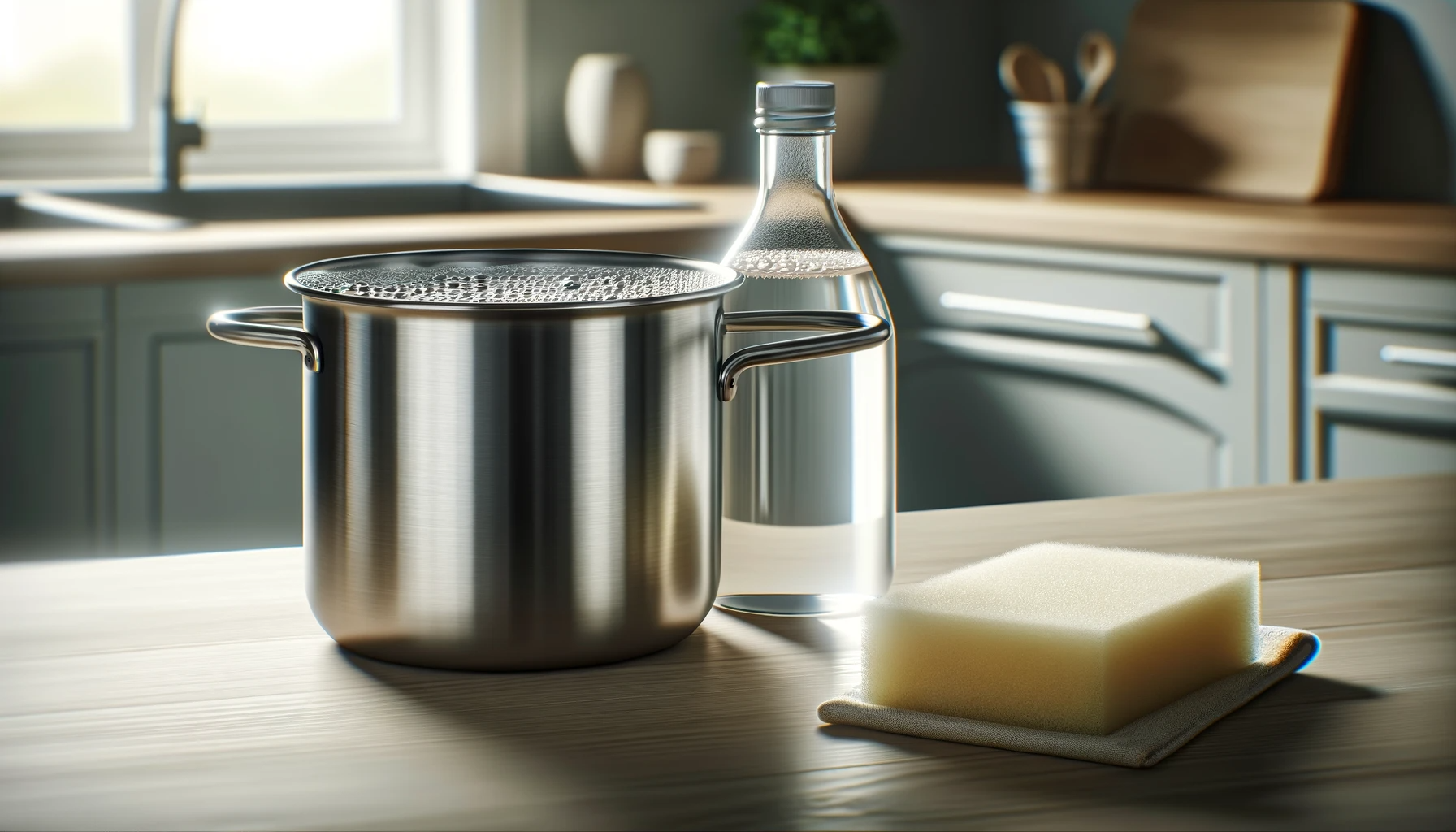If your stainless steel pots have seen better days with greasy, burnt-on messes, don’t trash them yet – vinegar can work wonders.
Cleaning stainless steel cookware with vinegar is a smart, non-abrasive method that saves money while removing grime and bacteria easily using supplies already at home.
Let’s dive into an actionable guide on renewing pots and pans safely with the power of vinegar…
How to Clean Stainless Steel Cookware with Vinegar
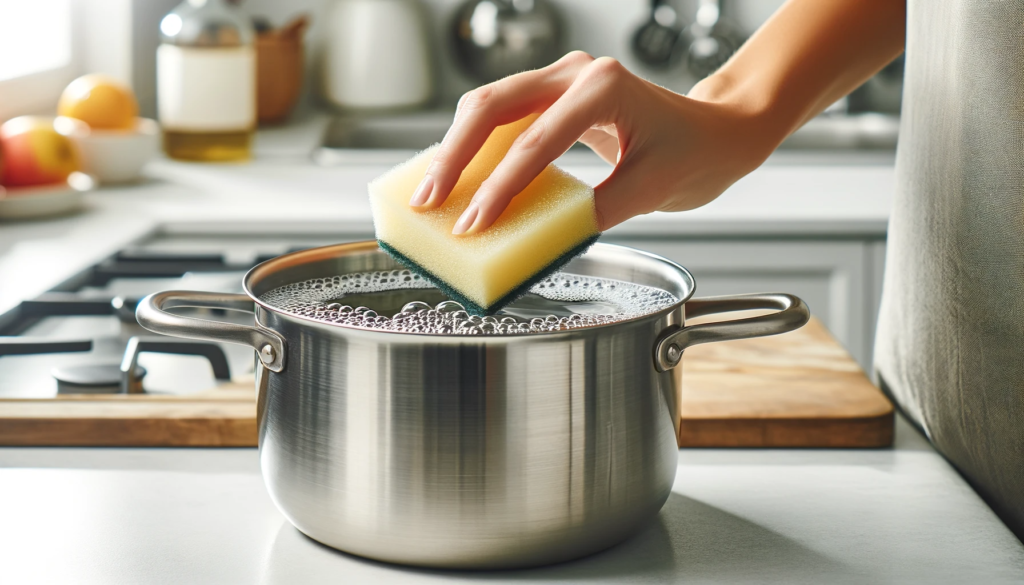
The easiest way to clean stainless steel cookware with vinegar is to fill or coat the inside of pots and pans with undiluted distilled white or apple cider vinegar.
Let it soak for at least 10 minutes up to an hour before scrubbing gently with a soft sponge or cloth.
Vinegar will lift baked-on grease and food residue without abrasives.
For exterior surfaces, spray full strength vinegar then wipe away grime.
We’ll explore the details of making filthy stainless steel cookware look brand new with this safe, eco-friendly method below.
Why Use Vinegar to Clean Stainless Steel Cookware

Cleaning stainless steel pots and pans can be challenging because food and grease residues can really bake onto the surface over time.
Many people reach for harsh chemical cleaners and abrasive scrubbers to try removing the mess, but that often backfires by damaging the finish of expensive cookware.
Vinegar provides an inexpensive, non-abrasive, and effective method for cleaning while sanitizing and deodorizing at the same time.
Vinegar is a mild acid that is strong enough to break down grease, oil, mineral deposits from water, and other grime.
When used correctly, vinegar will not etch or corrode stainless steel.
The acetic acid in vinegars also kills bacteria, viruses, mold, and germs, helping sanitize cookware while cleaning it.
Distilled white vinegar or apple cider vinegar work best rather than more acidic variations like red wine or balsamic.
Using gentle vinegar and water for cleaning preserves the durable shine and finish of high-quality stainless steel pots and pans.
Vinegar’s acidity safely lifts dirt from the surface without eroding the protective layer of chromium oxide.
This resistance to corrosion and rust is why stainless steel is so valued for cookware over other metals.
Avoiding abrasives during cleaning maintains smooth cooking surfaces going forward.
Vinegar is also extremely affordable and versatile for household cleaning.
A gallon jug can cost between $2 to $5 United States dollars and tackle all kinds of messes beyond cookware.
Most homes already have vinegar stocked for cooking, salads, DIY, health drinks, and more.
Having a natural, non-toxic cleaner on hand saves money and trips to the store.
What You Need
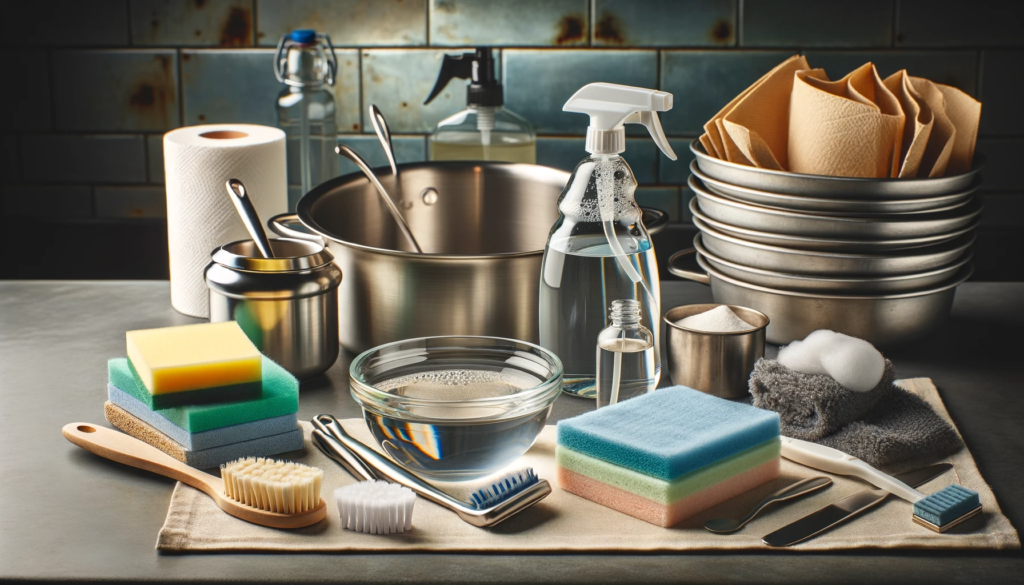
Getting started with cleaning stainless steel using vinegar requires just a few simple supplies.
As vinegar is the star of the show, make sure to have at least one type on hand – either distilled white vinegar or apple cider vinegar work best.
Stay away from thick balsamic vinegar variations for cleaning purposes.
Pour some vinegar into a bowl or spray bottle as needed.
Using a spray application allows you to thoroughly coat cookware surfaces.
For dealing with larger items like stockpots, having vinegar in a bowl for dipping scrub brushes or sponges is useful.
Make sure to protect countertop surfaces.
For scrubbing, soft sponges, microfiber cloths, or non-abrasive scrub pads are necessary to avoid scratching stainless steel finishes during cleaning.
Have paper towels or clean rags on hand to spot clean and polish dry.
An old toothbrush can get into smaller crevices in detailed cookware.
For extra cleansing power, baking soda can be mixed into a paste with the vinegar.
Avoid salty commercial cleanser mixes, lemon juice, wire brushes, steel wool, and anything too rough.
These can damage stainless steel coatings, removing protective layers.
Cleaning the Inside of Pots and Pans
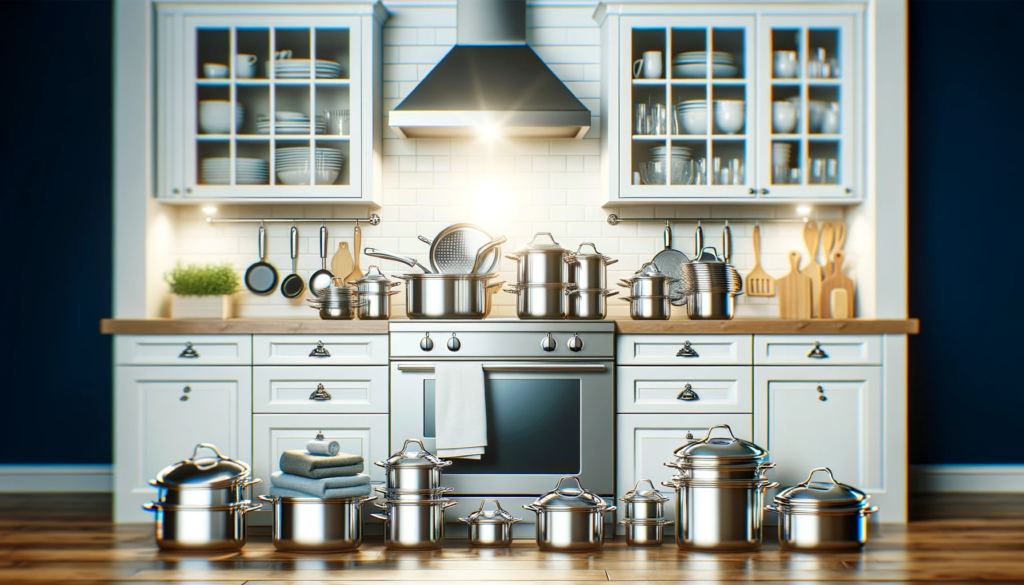
Cleaning baked-on residue from the interior of stainless steel pots and pans is easy with some vinegar soaking time.
The vinegar helps lift burnt food bits without harsh scrubbing.
For light grime, applying a vinegar paste may suffice.
But tougher messes benefit from a deeper soaking of the cookware item.
Start by evaluating how dirty the inside of a pot or pan may be.
For light grease or food residue without significant blackened areas, rubbing a paste of baking soda and vinegar onto surfaces followed promptly by rinsing can remove debris without soaking first.
For pots and pans neglected after cooking meals and left to sit with oil hardened onto sides, longer soaking is best.
For soaking, place the cookware item into a larger container or sink basin while cleaning to contain the vinegar bath.
Fill the dirty pot or pan with undiluted distilled white or apple cider vinegar until all affected areas are submerged.
For larger stockpots, this may use over a quart of vinegar.
Smaller pans may only require a cup or less poured inside.
Allow the vinegar to soak into stuck-on food buildup for at least 10 minutes but up to an hour for the heaviest of grime.
Once the allotted soaking time has finished, scrub the inside of the pot or pan gently with a dish sponge, soft cloth, or non-abrasive pad.
The vinegar will have loosened burnt bits but elbow grease is still required to remove residues.
Avoid using anything that could scratch delicate brushed or shiny finishes.
Be patient and let vinegar re-soak if needed for stubborn areas.
Cleaning the Outside Surfaces
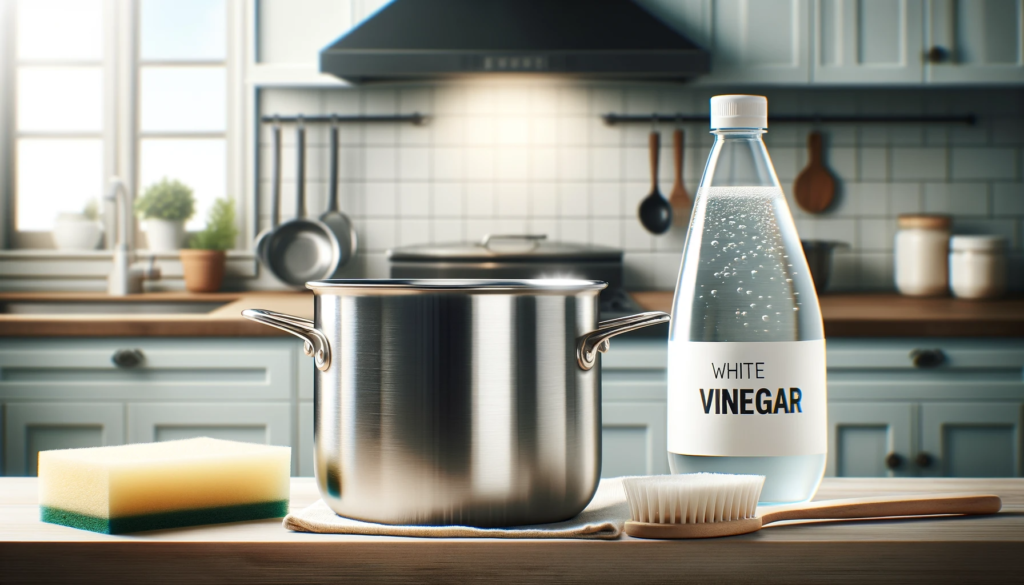
In addition to cleaning stuck-on messes from the inside of pots and pans, vinegar also works well for treating dingy exteriors.
Greasy handprints, fingerprint smudges, alkali water deposits, dust, and food splatter accumulate on the outside of stainless steel cookware over time.
Vinegar helps restore shine and sanitize.
When tackling external surfaces of pots and pans, spraying full strength vinegar directly from a bottle is easiest for full coverage.
Let the vinegar soak for a few minutes before wiping.
Use a soft microfiber cloth, dish sponge, or paper towel to remove grimy residue without abrasion.
If using a deeper basin or sink filled with a vinegar bath to soak cookware, briefly submerge smaller pieces fully to coat all sides before removing.
Larger stockpots can have vinegar wiped on manually.
Start by wetting down exterior surfaces thoroughly before scrubbing.
Reapply vinegar as needed to help lift debris.
For tough baked-on splatters or water stains on cookware exteriors, use the bubbling power of baking soda combined with vinegar.
Make a paste with equal parts vinegar and baking soda – about 1/4 cup baking soda to 1/4 cup vinegar.
Spot spread paste on stubborn spots and let sit for 5 to 10 minutes before scrubbing.
Rinse fully afterwards.
Be sure to hand dry stainless steel cookware carefully once cleaned to prevent additional water spots.
Use a clean soft towel or microfiber cloth designed for shining delicate surfaces without leaving lint behind.
Avoid bleach diluted solutions for cleaning exteriors as this can damage finishes over time.
Final Tips
Prevent significant buildup on stainless steel pots and pans by quickly hand washing after cooking while food debris is still fresh and pans are warmer.
Allowing oily residue or sugary drips to sit overnight cements grime onto surfaces.
Light maintenance cleaning is key.
When purchasing new higher-end stainless steel cookware, consider gently washing before the first use to remove any residues from packaging, handling, and dust.
Avoid keeping pans or lids stacked tightly together for storage as metal-on-metal friction over time can abrade finishes.
Nest cookware instead.
While vinegar is a great eco-friendly cleaner for stainless steel, some people prefer using a very diluted bleach solution for sanitizing.
Check manufacturer guidance before introducing harsh chlorine bleach onto expensive pots and pans.
Any cleaning product residues must be fully rinsed away after use.
Avoid using highly acidic lemon juice for cleaning stainless steel, as the citric acid and salty commercial cleansers can damage protective finishes over time and leave etching.
Discoloration and corrosion reduce performance.
Gently lift grime with vinegar instead and thoroughly rinse.
Conclusion
Vinegar offers a safe, affordable, and effective cleaning method for stainless steel cookware.
With some soaking time and gentle scrubbing, pots and pans can look bright and new again.
Stay on top of light maintenance cleaning whenever possible and take care to thoroughly rinse vinegar and avoid abrasives.
With this approach, quality stainless steel cookware will last for many healthy home cooking years.
